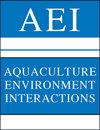在边缘:评估美国华盛顿威拉帕湾太平洋牡蛎养殖和鳗草之间的鱼类栖息地利用
IF 2.5
2区 农林科学
Q2 FISHERIES
引用次数: 10
摘要
河口受到各种人为压力的影响,如贝类水产养殖,这涉及广泛利用河口滩地。在美国西海岸河口,太平洋牡蛎、长牡蛎的养殖已经有一个世纪的历史,对当地的文化和经济做出了重大贡献。原生大叶藻(Zostera marina)也常见于进行牡蛎养殖的潮间带地区。在美国,大叶藻作为“重要的鱼类栖息地”受到联邦保护,限制了大叶藻内部或附近的水产养殖活动。为了提供对管理决策有用的科学信息,我们试图比较美国华盛顿州威拉帕湾牡蛎养殖和鳗草养殖的鱼类栖息地利用情况,以及这两种栖息地之间的边界。此外,考虑到最近转向海底外养殖方法,部分原因是为了保护海草,对长线和海底牡蛎养殖栖息地进行了比较。采用直接(水下录像,鲦鱼陷阱)和间接(捕食系绳装置,鳗草调查)相结合的方法来表征鱼类栖息地利用的差异。大叶藻密度在两种养殖生境中均有所下降,但在长线养殖生境中下降较少。在我们的研究中,大多数鱼类使用长线牡蛎养殖和大叶藻生境,边缘效应最小,使用底栖养殖的次数少于其他两种生境。这些结果与先前观察到的鱼类丰度与垂直生境结构之间的正相关关系一致,但也揭示了物种特异性行为;更大的中掠食者,如太平洋鹿角雕塑,在水产养殖中比在内部鳗草栖息地中更常见。本文章由计算机程序翻译,如有差异,请以英文原文为准。
On the edge: assessing fish habitat use across the boundary between Pacific oyster aquaculture and eelgrass in Willapa Bay, Washington, USA
Estuaries are subject to diverse anthropogenic stressors, such as shellfish aquaculture, which involve extensive use of estuarine tidelands. Pacific oyster Crassostrea gigas aquaculture is a century-old practice in US West Coast estuaries that contributes significantly to the regional culture and economy. Native eelgrass Zostera marina also commonly occurs in intertidal areas where oyster aquaculture is practiced. Eelgrass is federally protected in the USA as ‘essential fish habitat’, restricting aquaculture activities within or near eelgrass. To contribute scientific information useful for management decisions, we sought to compare fish habitat use of oyster aquaculture and eelgrass, as well as the edges between these 2 habitats, in Willapa Bay, Washington, USA. Furthermore, given a recent shift towards off-bottom culture methods, in part to protect seagrasses, long-line and on-bottom oyster aquaculture habitats were compared. A combination of direct (underwater video, minnow traps) and indirect (predation tethering units, eelgrass surveys) methods were employed to characterize differences in fish habitat use. Eelgrass density declined within both aquaculture habitats but less so within long-line aquaculture. Most fish species in our study used long-line oyster aquaculture and eelgrass habitats similarly with minimal edge effects, and on-bottom aquaculture was used less than either of the other 2 habitat types. These results are consistent with previously observed positive relationships between fish abundance and vertical habitat structure, but also reveal species-specific behavior; larger mesopredators like Pacific staghorn sculpins were sighted more often in aquaculture than in interior eelgrass habitats.
求助全文
通过发布文献求助,成功后即可免费获取论文全文。
去求助
来源期刊

Aquaculture Environment Interactions
FISHERIES-MARINE & FRESHWATER BIOLOGY
CiteScore
4.90
自引率
13.60%
发文量
15
审稿时长
>12 weeks
期刊介绍:
AEI presents rigorously refereed and carefully selected Research Articles, Reviews and Notes, as well as Comments/Reply Comments (for details see MEPS 228:1), Theme Sections and Opinion Pieces. For details consult the Guidelines for Authors. Papers may be concerned with interactions between aquaculture and the environment from local to ecosystem scales, at all levels of organisation and investigation. Areas covered include:
-Pollution and nutrient inputs; bio-accumulation and impacts of chemical compounds used in aquaculture.
-Effects on benthic and pelagic assemblages or processes that are related to aquaculture activities.
-Interactions of wild fauna (invertebrates, fishes, birds, mammals) with aquaculture activities; genetic impacts on wild populations.
-Parasite and pathogen interactions between farmed and wild stocks.
-Comparisons of the environmental effects of traditional and organic aquaculture.
-Introductions of alien species; escape and intentional releases (seeding) of cultured organisms into the wild.
-Effects of capture-based aquaculture (ranching).
-Interactions of aquaculture installations with biofouling organisms and consequences of biofouling control measures.
-Integrated multi-trophic aquaculture; comparisons of re-circulation and ‘open’ systems.
-Effects of climate change and environmental variability on aquaculture activities.
-Modelling of aquaculture–environment interactions; assessment of carrying capacity.
-Interactions between aquaculture and other industries (e.g. tourism, fisheries, transport).
-Policy and practice of aquaculture regulation directed towards environmental management; site selection, spatial planning, Integrated Coastal Zone Management, and eco-ethics.
 求助内容:
求助内容: 应助结果提醒方式:
应助结果提醒方式:


